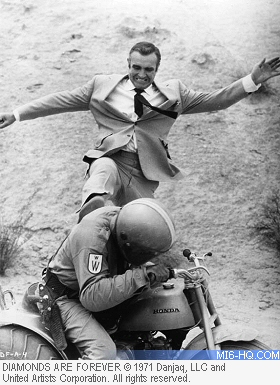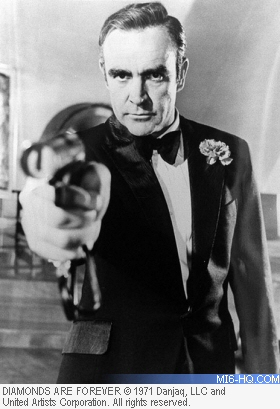 |
| |
MI6 uncovers a rare interview with Sean Connery on location in Las Vegas for "Diamonds Are Forever" filming in July 1971...
|
|
All Bets On Bond
30th March 2011
"Does Sean Connery still have that old 007 magic?" - July 10th, 1971 (The Montreal Gazette)
Here, in the betting bosom of America where slot machines squat in wait just beyond the airport arrival desk, where an instant American Dream rides on each roll of the dice and the pawning of false teeth, hearing aids and artificial limbs has only recently been outlawed, the biggest gamble of them all isn't on the green felt gaming boards.
It's a $7,000,000 bet that hangs in the balance over a set of second-floor business suites in the Strip's Hotel Riviera. There, two middle-aged movie moguls built like fire plugs, New Brunswick-born Harry Saltzman and his Bronx-bred partner Albert R. (Cubby) Broccoli, are sweating it out over the stakes announced in neon up on the Riviera marquee: "James Bond - 007 - Is Back." And the multi-million-dollar question they're bankrolling is: Will the old 007 magic work once more?
When they swore any actor could make a box-office dream out of Bond and promptly signed up an Australian male model named George Lazenby to prove their point in "On Her Majesty's Secret Service", they got a big surprise - and only half their previous gross. Could only Sean Connery put the formula into fast action? Or has the gilt-edged Bond glitter finally tarnished with time?
This year, once again without a Bond, they decided to go for a seventh in the streak and find out. Dusting off 'Diamonds Are Forever', Ian Fleming's 1956 suspense saga of international gem smuggling, the first Bond film ever to be shot on this side of the ocean, they hired Guy Hamilton who directed "Goldfinger", dreamed up a galaxy of phenomenal new gadgetry and never let the novel interfere with a script that was clearly conceived to outdo any previous epics for pure incredibility.
A sidecar pursuit across the desert was rewritten for a $10,000 moon machine. Where the book confided itself to the charms of Miss Tiffany Case, the movie adds Plenty O'Toole. |
|
 |
And in place of Fleming's rear-end collision, there's a modest 53-car chase down the main drag of Las Vegas climaxing in an eight-car aerial auto jump and a demolition-derby finale that sees 24 stunt cars consigned to the scrap heap.
Add the considerable assets of Hollywood jet-set darling Jill St. John, better known for her marriages than her movie roles, and Lana Wood, Natalie's little sister in every respect but vital statistics, and it all sounded like a promising package except for the slightest little hitch: With only two months to go until shooting started, Saltzman and Broccoli still didn't have a star.
In a last-minute gamble they tried to make contact with thew actor who hadn't spoken to them since he walked off "You Only Live Twice" years before. As Saltzman predicted accurately, "We knew he wouldn't even see us."
He would, and did, however, see their associate producer which showed they might have a chance - even if the first meeting accomplished nothing more than Connery selling him a second-hand Mercedes from an East London used car lot he'd bought. Then three days before shooting was to start, Connery came swinging in to Las Vegas airport with his ubiquitous golf bag over one shoulder and in his pocket the most spectacular deal in movie memory: A $1,250,000 fee which United Artists agreed to donate to his own Scottish International Educational Trust, a percentage of the profits and - the clause which clinched it - a $2,000,000 guarantee to produce, direct, write and star in any two pictures of his choice.
Now, in the second week of shooting, if it looked like one gamble was over, the biggest one had barely begun. Could a handful of new glamor gimmicks made the '60s Bond succeed in the '70s? Could Connery, nearly 10 years later, still kiss and kill with the same conviction he once had done? It's a risk the sat himself isn't unaware of. "The $7,000,000 question is," he jokes in an unguarded moment, "can James Bond still be the world's most popular wish fulfilment at 40?"
He leans against a Riviera slot machine waiting for the day's shooting, the white tux once again immaculate over 6 feet 2 inches and 190lbs of hard muscle that doesn't appear to have been dimmed by the decade. But a friend jokes with him about his weight and he takes umbrage. "I'm just the same as I always was," he snaps. "If I weren't in shape I would be by now. The first week I didn't get any sleep at all. We shot every night, I caught all the shows and played golf all day. On the weekend I collapsed - boy, did I collapse. Like a skull with legs."
It's a schedule that might lead one to believe Connery is just barely going through the Bond motions for the money - which he adamantly denies. "Oh, I think there's still some juice left in the old role," he says. "Besides, it's a very good job. One is very well paid." He goes off to face the cameras beside Lana Wood who won her role as Plenty O'Toole from a Playboy layout - for reasons which become immediately apparent with one glance at her cut-to-the-waist decolletage.
As the cameras roll, Connery throws the dice for a set of sixes to pick up a fictional $50,000. "Not bad," cracks an off-camera crew member, "for a guy who occasionally risks a quarter in the slot machines." Notoriously tight-fisted with his fortune, Connery does indeed spend the time between takes ranging up and down the slot machine corridors clutching a paper cupful of quarters and pumping away with all the little old ladies. He bends his elbow at one mechanical monster for a 10-minute stretch until it pays off in a flood of clinking quarters - then delays the next scene to pick every last one up off the floor while a boyish, un-Bondian grin spreads over his face.
It was money, in fact, which first disenchanted him with James Bond. "It's not that I needed the money," he says still fingering his dixie cup, "I'm a relatively wealthy man. It was the fact that I put in an awful lot of work and energy into the Bond pictures and was not sufficiently rewarded. The producers were getting greedy. I had an awful time getting the money out of them."
For "Dr. No", which earned six times it million-dollar cost back in the first two years, he got just $17,000. But by the end of his fifth Bond, even the reported million-dollar fee he had fought for wouldn't appease him. "It was the experience itself that became difficult," he says. "I felt the money for me wouldn't be enough to make another one worthwhile. There was no question that I was typed."
Friends confided that he yearned to be considered a serious actor alongside his wife Diane Cilento - separated from him, with their seven-year-old son Jason, since February [1971] - who won an Academy Award nomination for Tom Jones. But a succession of non-Bond box-office bombs took the wind out of his sails.
"I was disappointed - yes," he says, showing a veiled vulnerability in the set of his mouth. "For example, I thought 'A Fine Madness' would have been better had Jack Warner not cut it himself - which he did, very badly. And then when Sidney Lumet was up for two Academy Awards, MGM removed theirs for 'The Hill' to concentrate all their efforts on a bigger investment. It's this business side that makes it so difficult. But you're always going to be fighting it - because you're part of that system."
His urge to get behind the cameras, he says, isn't just an outcome of his disappointment with acting. "I've been going through this for a long time," he insists. "I was all set to direct a play by a Canadian, Ted Allen, on Broadway a few years back when the producer died. I directed my wife in one of his in London just before Christmas. It lasted three weeks - a sort of incestuous, unbalanced sister-brother sort of thing. Perfect fare for Christmas," he adds with a better-half-laugh.
The first project he does want to produce is a movie Macbeth - a role he once played on Toronto CBC with Zoe Caldwell - this time shot in Scotland, with Scottish actors and a strong Scottish burr to it all. His concern with things Scottish has, in fact become an overriding one ever since he set up a trust fund to help young Scots three years ago - a move his Bond fans might have seen coming had the Scotland Forever tattoo on his right arm not been powdered over for the screen.
 |
|
"It's a known fact in Scotland that we export more people than any other country in the world. Because basically there are so many ideas - and no money. But you can't build a wall and keep people in. You've got to give them something to do. And that gave me the germ of an idea. It's to start our own renaissance."
So far he has set up a chair of drama at Strathclyde University, financed a Scottish film, drafted a newspaper to get in touch with prodigal Scots around the globe and arranged for the British premiere of his latest film, "The Anderson Tapes" to be "The first ever to be held in Glasgow," he says with genuine pride.
He's still in the midst of a burst of Scottish exuberance when director Hamilton calls him for the day's last scene. On goes the immaculate tux, a make-up girl flicks a comb through his locks and he proceeds through a champagne dinner sequence accompanied by a topless mermaid who plucks a harp while plying up and down the dining-room lagoon in a motorized boat. |
It's James Bond in the most tinselled tradition. And then a curious thing happens. The scene ends, the klieg lights click off and a small make-up contingent gathers around Connery, goes through some hurried motions and comes away with a handful of hair. It is (gasp) Connery uncovered - a thinning pate of brownish strands left where on a minute before there were thick waves, and a face that is now suddenly flattened and aged.
Whether conscious of oblivious or if all, he beats a hasty retreat toward his afternoon game of golf which neither wind nor rain, interviews nor toupees are allowed to interrupt. At the look of shock on a female face in his wake, the make-up man left holding the hairpiece gives a chuckle. "You know," he says, "I sometimes think that the reason he doesn't want to do any more Bond pictures is that he hates this bloomin' thing so much."